We will tell this story from three separate viewpoints sources: The book The City of Hills and Kilns, by William C. Gates, Jr.
Joan Witt's article, One day in May which was published in "Goin' for More in 2004" Keep the Spirit Burnin! East Liverpool High School All-Class Reunion July 1, 2&3, 2004.
History of Columbiana County, Ohio - Harold B. Barth Historical Publishing Company 1926, CHAPTER XXIV MISCELLANEOUS
William McKinley
President McKinley at the McKinley farm near Lisbon, Ohio (Boy Scout Camp now). Picture from the Magic Lantern Glass Slides "Historical Slides of East Liverpool, Ohio Taken by Dr. C. H. Birkett.
National politics also became involved in the fight to win acceptance for labor organization in the East Liverpool pottery industry. The local Congressional campaign of 1882 between Republican William McKinley and Democratic nominee Jonathan Wallace became a hotly contested battle. Republican newspapers encouraged local citizens to vote for McKinley and theprotective tariff and denounced statements by rival periodicals which proclaimed that McKinley's defeat would be the severest blow the "bosses" of East Liverpool, Ohio could receive. The editor of the Potter's Gazette argued that without the employers, there would be no potteries, no workmen, no business, and asked rhetorically if there was a voter in town who did not wish to promote the interest of the potteries. Two local potters, William Beardmore and Joseph Barlow, arranged to have McKinley speak in East Liverpool. He addressed an audience on the eve of the election at Brunt's Opera House where he stated that he believed the men had the right to unionize. McKinley was known, however, for his close association with several local manufacturers and his speech did not sway most of the potters who traditionally voted the Republican ticket. Workers, striking out against employers, did not vote for McKinley, who lost the election. 59
In order to understand the factors that precipitated a strike of East Liverpool potters in 1894, it is important to look briefly at the tariff issue and labor relations, as well as state and national politics during the early 1890s. East Liverpool's pottery manufacturers and American industrialists in general were riding high in 1891 following the passage of Congressman William McKinley's protective tariff. Protective rates were important throughout the industrialized Upper Ohio Valley. The McKinley tariff not only raised the duty on imports but also required that every item exported to the United States after 1891 had to be marked in English with its country of origin. The protective tariff continued to have many advocates in East Liverpool as evidenced by the "McKinley Tariff Club" organized in the city in 1888. Republican adherents of the tariff argued that the new law would stimulate industry and would neutralize the free trade policy 'of the Democrats. When McKinley ran against Democrat James E. Campbell in the Ohio gubernatorial campaign of 1891, many of the issues centered on the nation as a whole rather than on the state of Ohio. McKinley opened his campaign in East Liverpool during a visit with his long-time friend John N. Taylor of Knowles, Taylor and Knowles. Following a reception at Taylor's residence on Sixth Street and a huge parade, McKinley made it clear that the keynote of his campaign was "Protection" for American industry. He told spectators exactly what they wanted to hear. McKinley said that East Liverpool had progressed ". . . from a poor little village, with meager schools and poor public improvements, to a thriving manufacturing city . . . this prosperity will continue, and increase, just so long as the Republican party is continued in power."!! 150-The City of Hills and Kilns
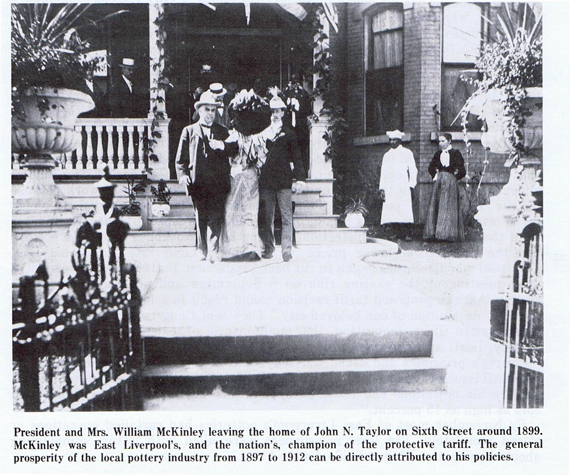
One Day in May
By JOAN WITT
On May 14, 1912, a unique event took place in East Liverpool - an event that probably will never be repeated! Two presidents of the United States of the same political party visited the city - on the same day! To be exact President William H. Taft was here in the morning and former President Theodore Roosevelt was here in the early afternoon.
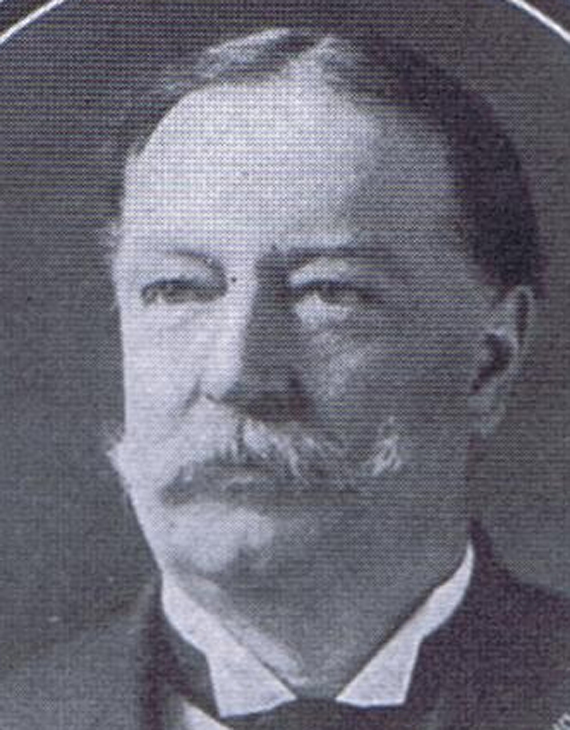
The unusual situation occurred when former President Roosevelt decided to challenge Taft for the Republican nomination. Taft had been his hand-picked replacement after two terms in office, but late in Taft's term, "Teddy" announced that he would again like to be president. He didn't feel that Taft had followed through on the Republican platform.
The two both arrived on the same day, just one week before the primary election day in Ohio. Notes on their plans were on the front page of the papers for days before the event took place. Leaders of the Republican Party in the city determined just who would be on the greeting committees and meet and transport the two gentlemen. Many details had to be made including stopping the street cars from being in the Diamond for a period of time; transportation from the train station to the location of the speech; and, in particular, security for both of them. Mayor Marshall announced that ten additional special duty officers would augment the regular force of officers.
The school students were dismissed for the day so that they could meet both men. President Taft began his remarks with a short address to the students who were standing directly in front of the Taft headquarters on the Diamond. He left a note for the students of the East Liverpool High School. The letter is still in the possession of the city schools.

The note From President Taft to the students of East Liverpool High School. Source: Keramos, Vol. III East Liverpool, Ohio. May 1912, No. 6.
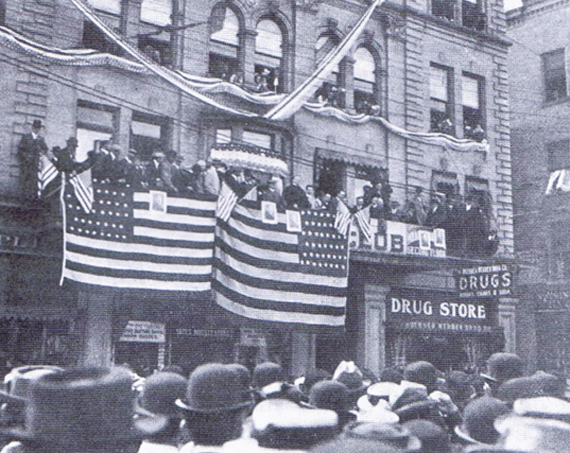
Crowds estimated at about 10,000 greeted each candidate that day. Taft spoke from the Taft headquarters of the east side of the Diamond at 9:30 a.m. after arriving from Steubenville, where a rally was held the night before. Roosevelt arrived about one o'clock and spoke from a stage area set up on Broadway near the Basil Simms home (now Kent State Parking lot [catty corner from the former PNB/Smith Auto Parts building]).
Taft was taken from the train station to the Diamond in Col. John Taylor's touring car. A city band led the entourage. Attorney Ben Bennett, chairman of the local Taft Committee introduced the president. Other leaders of Taft group included Col. Taylor, W.V. Blake, George Davidson, Walter P. Hill, Jason Brookes and T.A. McNicol.
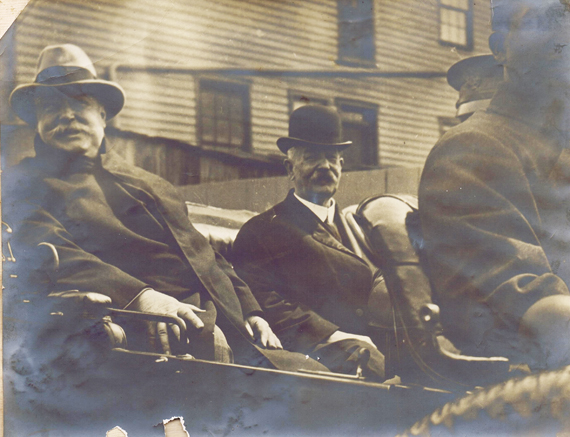
William Howard Taft (left) and John N. Taylor, East Liverpool, Ohio, May 14, 1912.
About two hours after Taft left on his hectic schedule, Roosevelt's train arrived. He was escorted to the Broadway location for his speech. Leaders backing Roosevelt included G.Y. Travis, Joseph T. Herbert, Homer J. Taylor, William Nicholson, W.W. Bagley and J.T. Smith. The area around the library, the high school buildings and Fourth and Broadway was packed with people to hear Roosevelt.
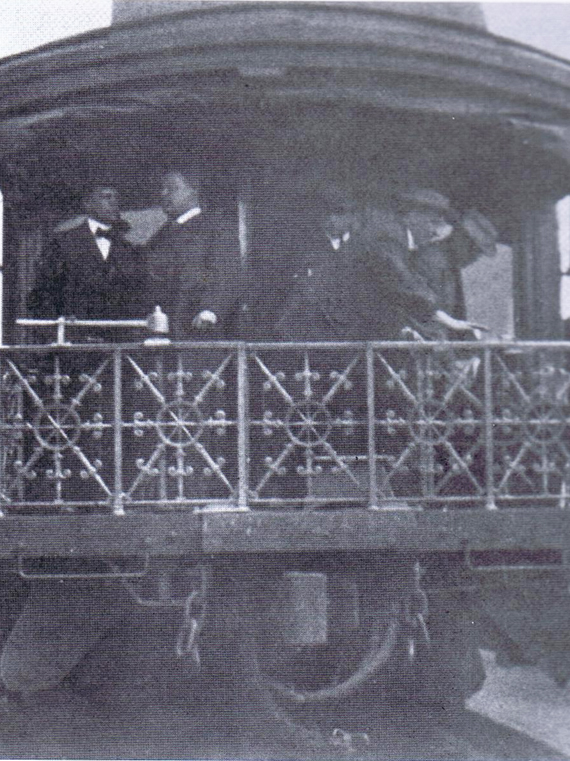
Just to add to the activities of the community that day, there was a circus scheduled in Wellsville that evening!
The primary election system for delegates was somewhat new in 1912, and it was unheard of for anyone to seek a third term. Thus, it was a new situation that Roosevelt would "again" throw his hat in the ring! The two men had gotten along most of the time, it was late in the winter o f 1912 that Teddy felt that Taft was not following the party agenda and wanted to continue policies that had been in place when he was president.
In 1912 the travel conditions and communications were not as fast as they were today. Each man had to travel by train, and the party leaders here in town had to contact them by telegraph or telephone to make final arrangements. Each man had two or three cars for himself on the trains. Taft came here from Steubenville with a short stop in Toronto and then was off to Alliance, Canton, Massillon, Akron, Ravenna, Warren, Niles and Youngstown. Roosevelt arrived here from Bellaire with short stops in Bridgeport, Mingo, Steubenville, Toronto and Wellsville. He left here to go on to Alliance and Youngstown. The two men crisscrossed the state and followed very hectic schedules in trying to visit as many towns as possible. Often by the end of the day, they were almost unable to speak.
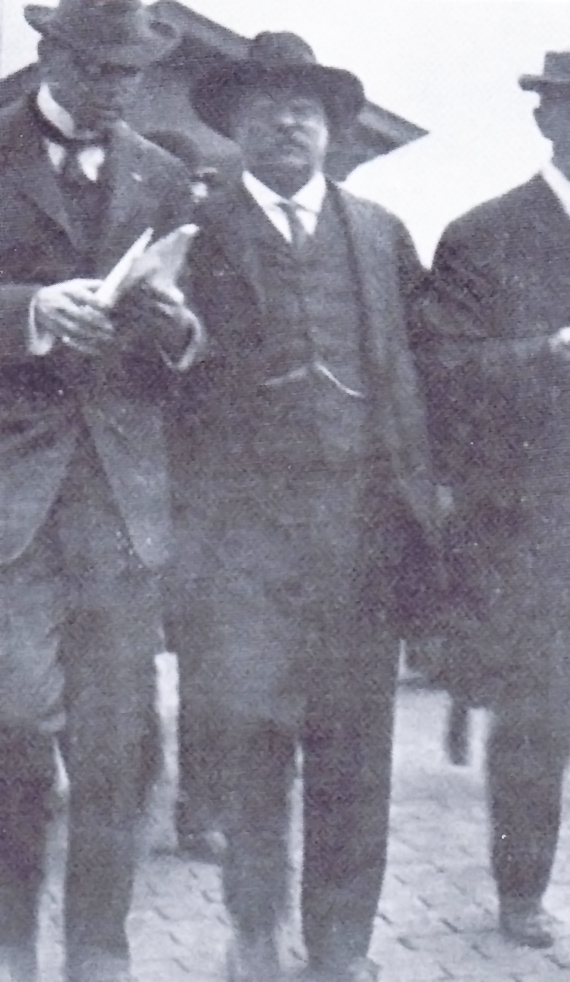
When the votes were all tabulated after the primary election, Roosevelt had won the majority of delegates. However, Taft had enough from other states to receive the nomination at the Republican Convention. Roosevelt after that left the Republican Party and ran as a candidate for president on the Bull Moose Party ticket. The results of the election in November showed that Woodrow Wilson was elected president. At a later time, William H. Taft was appointed Chief Justice of the Supreme Court.
Not many school students have the opportunity to be close to a candidate for national office, wonder how the students of East Liverpool and St. Al's schools felt after that experience?
SOURCE: "Goin' for More in 2004" Keep the Spirit Burnin! East Liverpool High School All-Class Reunion July 1, 2&3, 2004
Presidential Candidates Visit Here.
What approximated East Liverpool's greatest day occurred on Wednesday, May 15, 1912, during the notable and historic preferential primary campaign for Ohio's delegates to the Chicago Republican presidential convention in the following June when the two contestants, President William Howard Taft and the only then living ex-president of the United States, Theodore Roosevelt, visited the city that morning within two hours of each other, delivered significant and pertinent addresses, were thunderously applauded and generously extolled by the thousands of residents and visitors who, keyed up by two such major attractions, decided to round out the gala and unprecedented 24-hour period by attending en masse the world's greatest show, that of the Ringling Brothers in Wellsville, four miles away, in the afternoon and evening.
Just before nine o'clock ere the murkiness of the Ohio Valley had altogether been dispelled by the slowly rising sun a several-coach special train rolled in noiselessly into the Pennsylvania depot just off Second Street and President Taft, escorted by a committee that had met him several stations down the line and which consisted of Col. John N. Taylor, Mayor R. J. Marshall, H. N. Harker, Ben L. Bennett, T. A. McNicol, Jason H. Brookes, W. E. Wells and Walter L. Hill, motored to the rooms of the Buckeye Club in the Diamond, from the porch of which he almost immediately addressed the great throng which from before daylight had assembled to hear him. He was accompanied by Major Rhoades, his military aid, who had just succeeded the lamented Major Butts, who had but a few weeks previously gone down in the Titanic disaster, and several secret service and news men. He was introduced by Attorney Ben L. Bennett. Following his address he signed a book that the East Liverpool High School might have his signature and was taken back to his train. It, however, had been run to Wellsville and did not return for nearly half an hour during which interim the president sat alone in his automobile at the foot of Union Street while the secret service men prevented all from going near him. His wait, however, enabled many to take a Kodak likeness of him as a souvenir of the second visit to the city of a president of the United States while in office.
Hardly had President Taft's party disappeared before another special train, carrying the ubiquitous newspaper correspondents, his immediate entourage of close friends and another East Liverpool reception committee that comprised of G. Y. Travis, W. W. Bagley, Josiah T. Herbert, J. T. Smith, Homer J. Taylor and William Nicholson with the redoubtable "Teddy" slid silently to the spot which his successor in the White House had but quitted. The doughty "Colonel" came out of the rear door of the last car. The crown yelled. Off came the noted campaign hat that was worn and almost torn in its recent excursions into the political ring. The onlookers, recognizing the headgear, released another yell whereupon the hero of El Caney parted his lips in a reciprocal smile and the famous teeth came into close-up view. Bedlam occurred in intermittent fashion as he rode in motor car to the grandstand erected on the lot in front of the attractive home of B. C. Sims on Broadway from where the candidate for a third term declared his reasons for again seeking the place that he had quitted three years before to hunt lions in Africa.
B.C. Sims house
He was introduced by Attorney G. Y. Travis. A continuous ovation was given this noted visitor as her returned to the depot, his stay in the city being less than an hour. More than 10,000 persons, it was estimated, heard the two statesmen during their East Liverpool visit.
Presidential Visit.
- After an absence from the city of four years, he having visited East Liverpool as Ohio's governor in 1895 and frequently previously as the eighteenth district's congressman, President and Mrs. William McKinley honored the community by spending two nights and a day and a half here on Aug. 28-29, 1899, after passing the preceding Monday in Pittsburg following a vacation at Lake Champlain in New England.
While here he was the guest of Col. And Mrs. John N. Taylor in their then palatial home on Sixth Street which by now has been razed and transformed into a city lot. Besides numerous secret service men the president was accompanied by his then secretary, George B. Cortelyou, his physician, Dr. P. M. Rixey, and official stenographer, B. F. Barnes, afterwards the president's assistant secretary and under President Roosevelt the postmaster of Washington, D. C. The special train was composed of three Pullmans: "The Cleopatra," which he and Mrs. McKinley occupied and the "Patagonia" and "Atlantic." They were met in Pittsburg where they had been entertained at the home of Robert Pitcairn, of Shady Side by Col. Taylor and W. L. Smith, Sr.
Arriving here at 10:30 o'clock they were met by a huge crowd at the C. & P. Station. A carriage drawn by white horses drew them and Col Taylor west on Second to Washington, to Fifth and under an erected arch on the Diamond from which the words in electric lights, "Our President," dazzled even the visiting executive. They descended on Sixth Street and entered the mansion through a dense throng of people as Hayne's band played "Hail to the Chief" and other martial songs. During the journey from the depot a sons of veterans' contingent at Fourth and Broadway boomed the presidential salute of 21 guns from a cannon.
Despite the lateness of the hour the populace would not be appeased without a word from their former representative in congress whom so many knew personally.
He finally came outside and from the porch off which he had frequently spoken to the same audience he thanked the people for their kind reception, expressed his weariness and declared, "my coming to East Liverpool always awakens the tenderest of heart springs."
The next morning President and Mrs. McKinley were taken riding across the new Chester, W. Va., bridge by Col. And Mrs. Taylor, while Secretay Cortelyou, Dr. Rixey and Mrs. Barnes were given a view of the hill tops by Col. Taylor's son, Will Taylor.
A feature of the president's ride was that it was taken in his once own carriage which had carried all the public men of the country to the McKinley home during the famous porch campaign of 1896 which he had presented to Col. Taylor when he assumed the presidency.
History of Columbiana County, Ohio - Harold B. Barth Historical Publishing Company 1926, CHAPTER XXIV, MISCELLANEOUS
This site is the property of the East Liverpool Historical Society.
Regular linking, i.e. providing the URL of the East Liverpool Historical Society web site for viewers to click on and be taken to the East Liverpool Historical Society entry portal or to any specific article on the website is legally permitted.
Hyperlinking, or as it is also called framing, without permission is not permitted.
Legally speaking framing is still in a murky area of the law though there have been court cases in which framing has been seen as violation of copyright law. Many cases that were taken to court ended up settling out-of-court with the one doing the framing agreeing to cease framing and to just use a regular link to the other site.
The East Liverpool Historical Society pays fees to keep their site online. A person framing the Society site is effectively presenting the entire East Liverpool Historical Society web site as his own site and doing it at no cost to himself, i.e. stealing the site.
The East Liverpool Historical Society reserves the right to charge such an individual a fee for the use of the Society’s material.